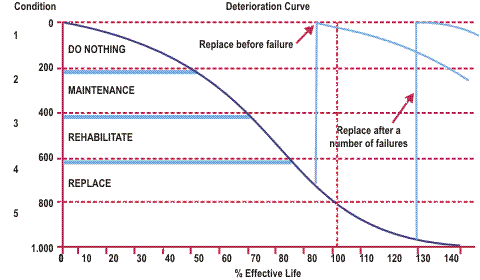Construct the Model
After the various benefits have been identified, the next step is to determine the effect of different strategies:
Reduced operations and maintenance
A different maintenance regime will most probably have minor improvement on O&M costs, whereas rehabilitation may immediately reduce the current operation and maintenance cost. The initial savings in O&M costs will however begin to taper off as the years go by. It is therefore necessary to determine how the effect is taking place.
For simplicity, it can be assumed that the savings in O&M will be depleted when the level of service has fallen to the original level just before treatment. For example, if the treatment has to be repeated in 5 years in order to bring the asset condition back to the original level, and the estimate O&M cost saving is 20% immediately after the treatment, the saving is assumed to be reducing by 4% each year until it is finally lost at the end of year 5.
Extension of asset life
The various options for renewal will have different impacts on life of the asset. Maintenance may extend the life, rehabilitation will extend the life and replacement will obviously reproduce the original life. Of course each option will have a radically different cost.
Level of services
The level of service can be measured in terms of customers' expectations. Issues such as statutory requirements and existing conditions, play an important role in evaluating the level of service. Consideration needs to be given to such factors as:
- Quality
- Quantity
- Ride (Road Asset)
- Pressure (water) etc.
- Improved production (income). This can be estimated based on the increased revenue collection.
Risk cost reduction
This benefit actually relates to the reduction of risk cost. The treatment will improve the condition of the asset and reduce the probability of failure. It is necessary to estimate the reduction of the current risk cost once the treatment is in place. This information can be made available from risk management models.
For each option the total costs and benefits are aggregated during each year and discounted to the time when the treatment is actually completed. The ratios of cost/benefits provide useful comparison of the effectiveness of the various options.
However, because of the timing of the different options, and the avoidance of the risk cost with early treatment it is necessary to analyze the cost/benefit ratios on a common time base. This will involve additional input in estimating the probable risk cost during the interim period for those options, which are required during the latter date.
We then need to construct the inputs for the various treatment options:
- Non asset options (manage differently)
- Asset options, including:
- Do nothing
- Maintenance — more, less, status quo, repair only (do nothing)
- Rehabilitate
- Replace.


